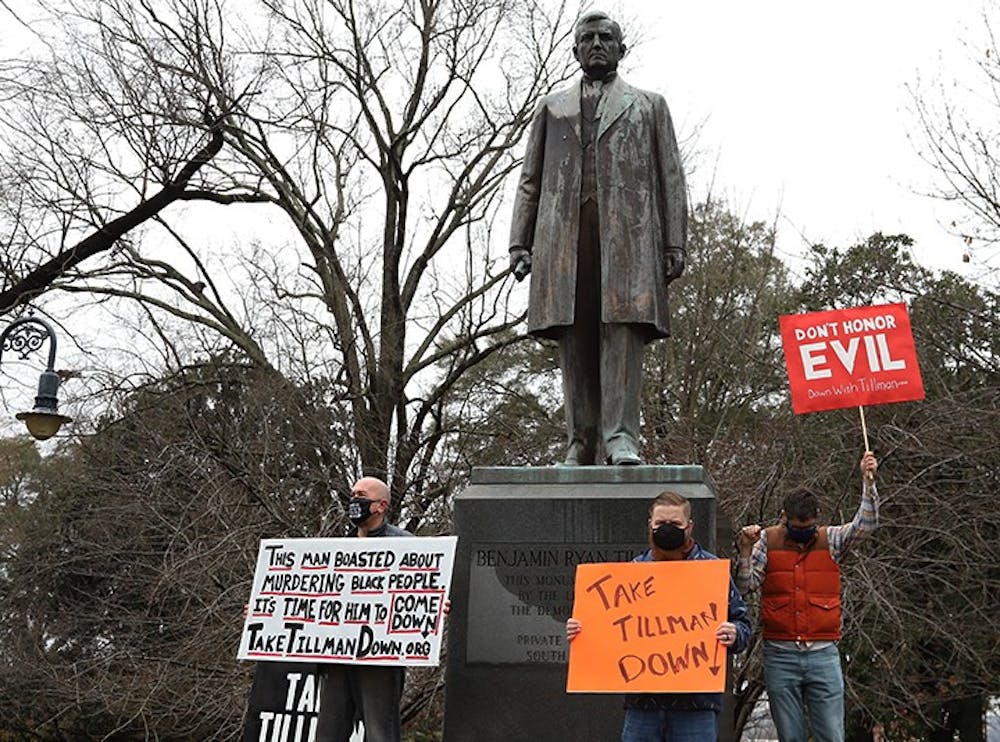State Rep. Seth Rose and Historic Columbia joined protesters Tuesday to call for the removal of former South Carolina Gov. Benjamin Tillman’s statue from the Statehouse grounds.
Betsy Kleinfelder, interpretive services coordinator for Historic Columbia, said the protests were due to Tillman’s legacy of white supremacy.
“His entire dedicated mission was segregation, was to push the white race forward and to put the Black race down,” Kleinfelder said.
In his life, Tillman led a white supremacist paramilitary group known as the Red Shirts, introduced barriers to voting targeting African Americans, and, as governor, announced that he would “lead a lynching” in the state of South Carolina in 1892.
“There weren't a lot of other parts to him,” Kleinfelder said. “There weren't other, you know, redeemable acts or other things that he did. That was his drive.”
Steps have been taken to remove the statue. Rose has filed a bill in the South Carolina House of Representatives. If the statue falls underneath the Heritage Act, which protects South Carolina’s Confederate and Civil Rights monuments from removal or renaming, a two-thirds vote in both chambers of the state legislature will be required to take action.
Rose said he believes the Heritage Act should not apply for Tillman’s statue.
“He was not a Confederate soldier," Rose said. "He was a governor that stood for the open murdering of innocent African Americans."
Under the Heritage Act, "any local or state monument, marker, memorial, school, or street erected or named in honor of the Confederacy or the Civil Rights movement" falls under its jurisdiction.
Because the monument was erected at the start of South Carolina's Civil Rights movement in 1940, the Heritage Act could potentially apply. Kleinfelder, though, said erecting the monument at that time was a gesture against the Civil Rights movement.
“Putting up a monument to this man at that time was meant to be a part of intimidation and fear and to keep Black Americans down and to subjugate their rights,” Kleinfelder said.
An alternative to destroying the monument, some said, would be relocating it.
Tyler Trotter, creator of the website downwithtillman.com, said he disagreed with the argument that keeping the Tillman statue on the grounds was in the best interest of preserving history.
“I don't think anybody actually believes that argument, that people who say that this is for history," Trotter said. "Because if it is, how are we going to learn about the history of Dylann Roof? Do we need a monument for him to learn about that?”
A museum, home-school teacher Shannon Walker said, would be a more appropriate place for Tillman’s legacy.
“Museums don't have to just honor the good parts of history but really can, you know, also teach us about the mistakes that have been made,” Walker said. “There needs to be a way to find a new place for this history, and it shouldn't be here in a place of honor.”
Kleinfelder mirrored this sentiment, saying the monument explained Tillman’s legacy poorly.
“There's not anything on this monument that actually teaches you about who Ben Tillman was, what he did, what his actions were,” Kleinfelder said. “It's not something that's meant to be a teaching tool. That was never the intention of a monument.”

